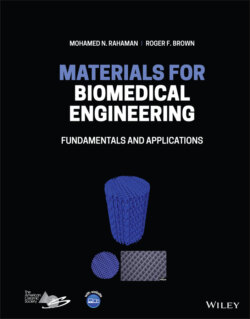Читать книгу Materials for Biomedical Engineering - Mohamed N. Rahaman - Страница 95
3.4.1 Point Defects
ОглавлениеPoint defects are defects associated with one or a few atomic sites in the crystal. The major types of point defects are illustrated in Figure 3.16. A different atom, called a foreign atom, that occupies the site of a regular atom in the pure crystal, called a host atom, is said to be a substitutional defect. A vacant atomic site is called a vacancy. Foreign atoms and host atoms can occupy the interstitial sites between the regular atomic positions, giving foreign interstitial defects and self‐interstitial defects, respectively.
Figure 3.16 Schematic representation of the types of point defects in a crystal.
The majority of metals are not used in their pure state because they often have inadequate properties for most applications. Instead, other metals are commonly added to them in various amounts, forming alloys with an improved combination of properties such as higher strength, fatigue resistance, and corrosion resistance. Atoms of the alloying metal occupy sites in the host metal structure, forming substitutional or interstitial defects. The alloying metal is said to form a solid solution with the host metal. When examined at a scale larger than the atomic scale, a solid solution is homogeneous. It can be visualized as a solid‐state analog of a liquid solution such as a solution formed by dissolving common salt (sodium chloride) in water. The amount of one metal that can be alloyed with another metal to form a solid solution can vary from less than a fraction of a percent by weight (abbreviated wt%) to nearly 100 wt%, depending on the combination of metals. Copper, for example, can dissolve more than 30 wt% zinc to form brass, forming a substitutional solid solution in which the zinc atoms occupy the regular atomic sites of copper. On the other hand, iron can dissolve no more than ~0.007 wt% carbon at room temperature to form an interstitial solid solution known as mild streel. Brass and mild steel, however, are not suitable for use as biomaterials on account of their low corrosion resistance in vivo.
A Ti alloy that is widely used as implants in orthopedic and dental surgery is Ti6Al4V, composed of ~6 wt% aluminum and ~4 wt% vanadium (V), with the remainder (~90 wt%) being Ti (Chapter 6). Although Ti6Al4V has an elastic modulus comparable to Ti, its superior strength, fatigue resistance, and corrosion resistance make it well suited for applications such as implants for total joint replacement, fracture fixation plates and dental implants. Certain stainless steels and cobalt–chromium (Co–Cr) alloys also find considerable use in orthopedic surgery.
Ceramic solid solutions are widely used in technological applications. One solid solution used in biomedical applications is YSZ, formed by adding ~3 mol% of yttria (Y2O3) to zirconia (ZrO2). In this solid solution, the yttrium (Y) atoms predominantly occupy the regular zirconium (Zr) sites in the host ZrO2 structure, resulting in the formation of substitutional defects. Vacant defect sites (vacancies) are also created in the process to compensate for the difference in valence between Y and Zr.
The inorganic constituent of bone and teeth is not pure hydroxyapatite, Ca10(PO4)(OH)2, but a highly substituted hydroxyapatite‐like material. This material has a structure that resembles that of hydroxyapatite but it contains approximately 4–8 wt% of (CO3)2−, often the main substituting species, smaller amounts of ions such as (HPO4)2−, Mg2+ and Na+ (less than ~1 wt%), and trace amounts of ions such as Sr2+, K+, F−, and Cl− (Posner and Betts 1975). While the defect chemistry of hydroxyapatite is complex, (CO3)2− and (HPO4)2− ions typically substitute at the anionic (PO4)3− sites in the crystal structure, whereas ions such Mg2+, Na+, Sr2+, and K+ substitute at the cationic Ca2+ sites, and F− and Cl− ions substitute for OH− ions (Figure 3.17).
Figure 3.17 Major substituting ions and approximated formula of hydroxyapatite‐like constituent of bone.
